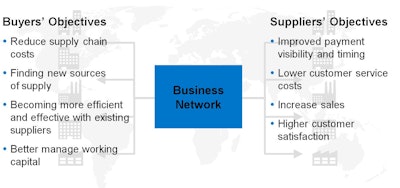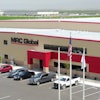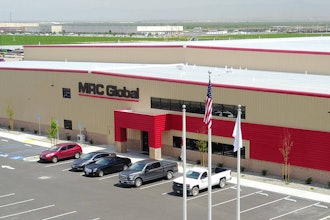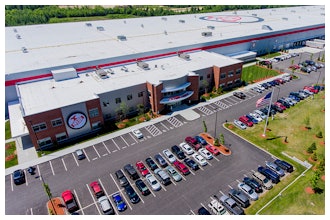
Imagine if the internet disappeared for a month. You will no longer have access to your favorite websites such as Amazon, Yahoo News, Google or American Express. You will have to make a trip to a store to buy your books, go to a library to do your research, visit a bank or ATM to transfer money between accounts and wait for the morning newspaper or watch CNN to catch the latest news. Sure, you did all that before the internet became ubiquitous. But once you got used to the convenience and instant access of the internet, going back to the old ways is unthinkable. Such is also the transformational power of a Business Network – once you get used to it, you will find it difficult to source or procure in a traditional manner.
A Business Network contains a suite of network connected and analytic applications and an ecosystem of buyers and suppliers that can use these applications for initiating sourcing relationships, buying products and services and identifying additional opportunities for increasing revenue or saving costs. It combines the two elements - the applications suite and the buyer-supplier ecosystem in a seamless and cohesive manner to replicate a real-life sourcing and procurement environment, and eliminates the artificial boundaries between the software and the network.
How is the Network different from traditional procurement software?
A Business Network extends the reach and power of the traditional procurement software currently used by many companies in the industry. Traditional procurement software consists of solutions such as sourcing, contract management, ePurchasing and spend analysis. It is typically used by employees within the four walls of a company. By adding an ecosystem of suppliers to the mix, as well as a suite of SaaS-based applications that enable supplier discovery, auctions, etc., the sourcing mechanisms can be significantly extended by the procurement organization. Similarly, if all transactions between the buyers and sellers that flow through the network are aggregated by the analytics application within the Business Network, significant intelligence can be obtained and leveraged to enable better sourcing decisions. For example, you will be able to see which suppliers have better on-time delivery metrics or show more flexibility in changes to the orders or provide better pricing on volume and include them in sourcing decisions.
This scenario is similar to banks who initially offered web-based access to your accounts, so you could check your deposits and withdrawals online and transfer money between accounts at the same bank - similar to traditional procurement software. The banks then integrated the financial ecosystem into their offering (similar to the Business Network) to provide you the seamless capability to pay all your bills to any business of any size irrespective of where they bank; search for CDs and other investment instruments and buy/sell them, setup and receive direct payments from your customers and make payroll to your employees. These network capabilities don’t replace the traditional deposit/withdrawal capability, but significantly extends it. Banks can also use aggregated transaction information to understand trends, identify loyal customers and extend their ‘share of the money’ with a client. Business Networks offer similar increase in scope and reach to the procurement function.
Creating a Win-Win within a Business Network
A Business Network meets the business objectives of both the buyers and suppliers within an organization. The chart below identifies their respective business objectives and how the network meets them.
With the ecosystem and rich set of additional capabilities available, let’s closely examine the benefits of using a Business Network to a buying organization. The network improves the effectiveness of a buying organization’s current procurement process by enabling it to
- Easily find and select suppliers who offer catalog-ready environment, sell the desired portfolio of products and services and meet other criteria such as industry certifications, pricing and proximity. This allows buying organizations to quickly and cost-effectively expand their pool of qualified suppliers in order to optimize costs, quality and service levels.
- Participate in sourcing events such as reverse auctions and public RFPs through seamless integration of applications and network. These events allow buying organizations to expand the pool of suppliers to compete for their business and, as a result, reduce costs and improve service levels.
- Enable buying organizations to keep its supplier master record current by requiring the supplier to update using self service. Lack of such information often impedes other initiatives such as supplier rationalization, spend analysis etc.
- Access competitive benchmarks on price and purchase order cycle time for any item/commodity, so the buying organization can implement specific initiatives to either close the gap or get/stay ahead. Such valuable information, that optimizes costs and service levels, is otherwise very difficult to access.
- Network with peers to access best practices and practical ‘how to’ advice about your specific issues in context of your network and applications through user forums. Access to such specific information through generic industry forums may not be possible.
- Reduced cycle time and transaction cost of the source-to-contract and procure-to-pay processes. The following chart illustrates the efficiency gains from such a network
- Suppliers can easily distribute updated catalogs so the price list and product listing in the catalogs is current. Once the updated catalog is on the network, every buying organization gets access to that version of the catalog. Update and distribution process is typically expensive and inefficient, if a supplier is not on the network and each buying organization’s system needs to be sent updated catalogs one at a time.
The Network also creates a multiplier effect in terms of effectiveness and efficiency.
- According to Aberdeen Group analysis, enterprises connected through supplier networks are more likely to leverage electronic POs (69%), electronic payments (65%) and e-invoicing in their quest to decrease processing costs. This creates the multiplier effect by increasing the efficiency of everyone on the network, not just one buying organization and its supplier.
Suppliers also benefit significantly by participating in the network. The following chart illustrates the advantages to them. Business network improves their payment visibility and timing, and accelerates their order-to-cash cycle. The buyers can find them more easily (if they are a part of a Business Network) and engage them in RFPs or reverse auctions. This increases their opportunities to increase revenue. By engaging their customers better through the network, they also significantly increase their customer satisfaction metrics, increasing the scope of repeat business.
Siddharth Taparia is the Senior Director of Portfolio and Strategic Marketing at SAP. He can be contacted via twitter (@siddharth31






















